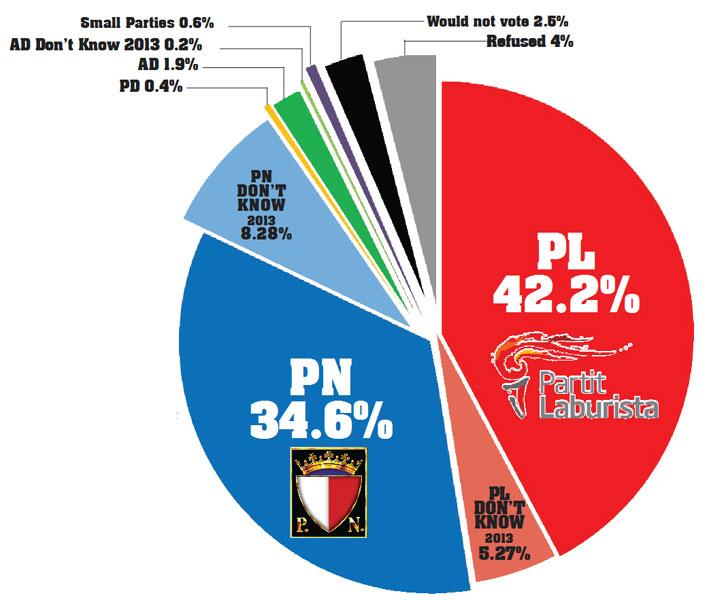While the Labour Party (PL) has managed to retain its lead over the Nationalist Party (PN) and Partit Demokratiku (PD), according to the second edition of The Malta Independent’s election iSurvey. Those who still ‘don’t know’ how they intend to vote have climbed from 10.8 per cent in the first week of the campaign to 13.8 per cent in a week.
The raw data from the iSurvey that takes into account the ‘don’t knows’, those who will not vote and those who refused to respond, shows a 7.2 per cent lead for PL over PN-PD. However, when taking the 13.8 per cent who are unsure of how they will be voting and split that section based on how those same respondents voted in the 2013 general election, should the ‘don’t knows’ vote in the same way that they did in 2013, the PL-PN gap narrows to 4.5 per cent.
Asked about their voting intentions, 42.2 per cent of respondents say they will be voting PL, 35 per cent will go to the PN-PD coalition (with PD only managing 0.4 per cent of the vote), 1.9 per cent went to AD and 0.6 per cent to ‘other small parties’. 2.5 per cent say they will not vote or are still unsure as to whether they will, 13.8 per cent are undecided on who to vote for and 4 per cent refused to answer.

Between last week and this, it is interesting to note that the PL went down by 0.4 percentage points, the PN-PD coalition also went down by 1.6 percentage points and AD managed an increase of 1.4 percentage points.
Pundits have commented that the overuse of aggressive social media campaigns could have an isolating effect on the electorate. Others have mused that as the campaign intensifies, and the mainstream parties announce their increasingly populist electoral proposals, more respondents are genuinely undecided on how they will cast their vote.
The Malta Independent on Sunday, through its electoral iSurvey, has reviewed respondents’ voting intentions in order to gauge a snapshot of the current political climate ahead of the 3 June snap election. Last week’s iSurvey used a sample size of 600 and people were contacted between 25 April and 3 May. The second wave of the election iSurvey took place between 8 May and 11 May, and a sample size of 400 was used. The sample is then weighted to reflect the age, gender and spread of locality of Malta’s population.

How will the ‘don’t knows’ vote?
No one can doubt that it is the ‘don’t knows’ and switchers who will ultimately decide an election, as less and less people in Malta and Gozo are willing to extend unwavering support to one particular party.
Therefore, whenever surveys are carried out it is imperative to try and make an informed assumption on which way the ‘don’t knows’ will swing, apart from displaying the baseline figures which include ‘refused’ and ‘will not vote’. Ordinarily, surveyors may choose to remove the ‘don’t knows’ from the equation, which splits their vote evenly among all parties.
The Malta Independent on Sunday carried out an exercise in which it took the 13.8 per cent of those who say they don’t know how they will be voting in this latest edition of the iSurvey, and cross referenced this with how they actually voted in the 2013 general election.
This exercise therefore assumes that the 13.8 per cent undecided will be voting in the same way that they did in 2013.
After the appropriate adjustments, it was found that the gap between the PL and the PN-PD coalition narrows to 4.5 percentage points.
Overall, should ‘don’t knows’ retain their 2013 voting preference, the PL would have 50.8 per cent of the vote, PN-PD would manage 46.3 per cent, AD would go up to 2.4 per cent while ‘other small parties’ remain unchanged at 0.5 per cent.

Who are the switchers?
Future switchers were also identified through cross-referencing respondents’ voting intentions for the upcoming general election with how they voted in 2013. It was found that a proportion of nine per cent of those who voted PL in the 2013 general election say they will be voting PN this time around, and a proportion of four per cent who voted PN in the 2013 election will be voting PL this time around.
Intentions of switching therefore sway in favour of the PN at this point in time. This could be attributed to a segment of the population that traditionally voted PN, but were part of the many who decided to switch over to the PL camp in 2013 which promised change.
In view of the current corruption allegations plaguing the Prime Minister, his wife, Minister Konrad Mizzi and the Prime Minister’s chief of staff Keith Schembri, it therefore stands to reason that some of those who switched over to the PL would be returning to their PN roots this time around.
In 2013, the PL got 54.8 per cent of the vote while the PN had just 43.3 per cent of the vote, with a difference of 36,000 votes. This landslide victory for the PL was unprecedented, with the gap between the two big parties being that of 11.5 percentage points.
The April 2017 iSurvey – the eighth of its kind and the second in a series of electoral iSurveys– was commissioned to Business Leaders Malta on behalf of The Malta Independent. A total of 400 respondents were used, representative of age, gender and spread of localities. With such a sample size, the margin of error is +/- 4.9 per cent. More results will be published over the course of the coming week.